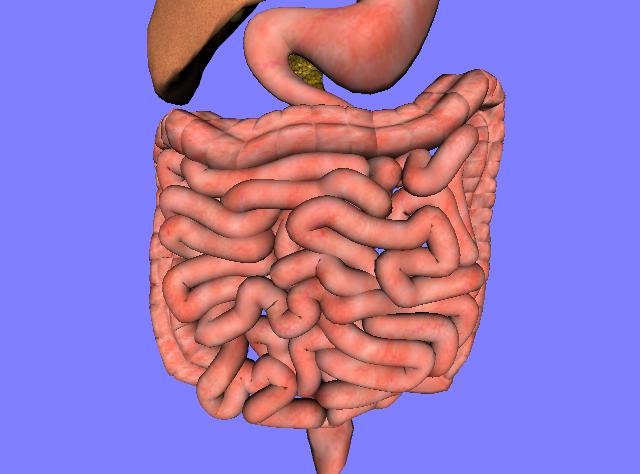The small intestine is continuous with the stomach at the sphincter and leads into large intestine at the ileocaeoal valve .
It is 5 mts long and lies in the abdominal cavity surrounded by the large intestine The important function of the small intestine is absorption of nutrients
The small intestine comprises 3 main section continuous with each other they are :
- Duodenum : The duodenum is about 25cm long secretion from the gall bladder and pancreas are released into the duodenum through a common structure known as sphincter of Oddi or Hepatopancreatic sphincter.
- Jejunum : It is the middle section of the small intestine and is about 2 mts long .
- Ileum : It is about 3 mts long and ends at the ileocaeoal valve which controls the flow of material from the ileum to the caecum , the first part of the large intestine and prevent regurgitation
Structure of small intestine
Movements of small intestine : Three types of movements are seen there are
- Peristalsis : It is a wave of contraction preceded by the wave of relaxation .this movement help in propelling the chyme. The speed of peristalsis in jejunum and ileum is 1.2-2.5 cm -sec . This type of movement is initiated neutrogenic drive .
- Segmentation : In this type of movement , circular muscle conduct at regular intervals thus dividing the intestine into number of segments . This type of movements help in mixing of food with digestive juice and absorption of digested food .
- Pendular : This movements is similar to segmentation but here segments move to and fro over the food in the Pendular fashion at the rate of 5 cm/sec . This type of movements help to mixing of food with digestive juice and absorption of the digestive food.
Process of digestion and functions of small intestine :
When acid chyme passes the small intestine it is mixed with pancreatic juice , bile juice ,and intestine juice and is conduct with the enterocytes of the villi . In the small intestine digestion of all the nutrient is completed
Composition of intestinal juice : About 1500 ml of intestinal and it consist of water , mucus and nineral salt , enzyme like sucrose, maltase, lactase ,erepsin. The pH of intestinal juice is about 7.8 -8.0
Composition of pancreatic juice : It consist water, mineral salt, amylase, lipase, inactive enzyme precursor’s such as trypsinogen, chymotrypsinogen and procarboxypeptidase. The pancreatic juice is alkaline ( pH 8 ) when the acid stomach contents enter duodenum they are mixed with pancreatic juice and the pH is raised to 6 and 8.
Digestion of proteins : Trypsinogen and Chymotrypsinogen are inactive enzyme precursors they get activated to ———–> Trypsin and chymotrypsin, by enterokinase enzyme in the microvilli.
Proteins is converted to primary proteases and secondary proteases, by the help of enzym is called as chymotrypsinogen and trypsin.
peptones, polypeptides, lower polypeptides and amino acides.
Digestion of carbohydrates ; starch and dextrin is convert to maltose by the enzyme is called pancreatic amylase.
Maltose to glucose by maltase, sucrose to glucose by sacrase
digestion of fat; fat to fatty acids and glycerol by the enzyme is pancreatic lipase.

